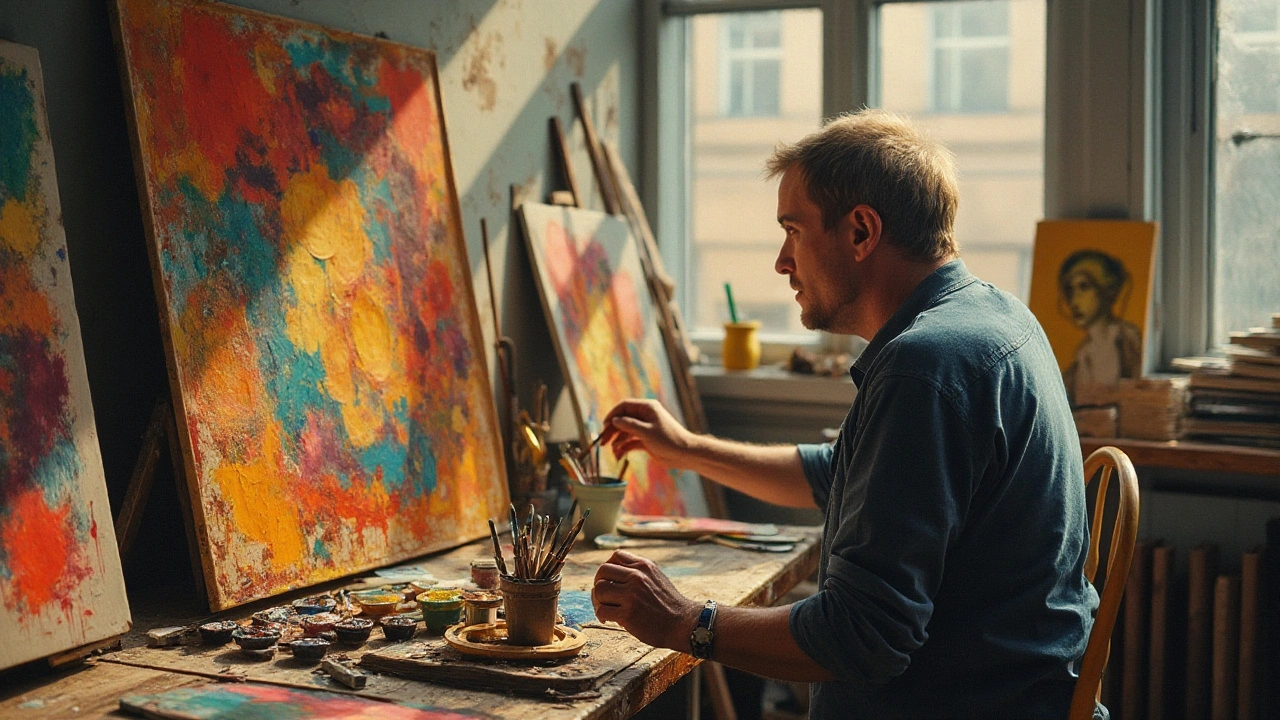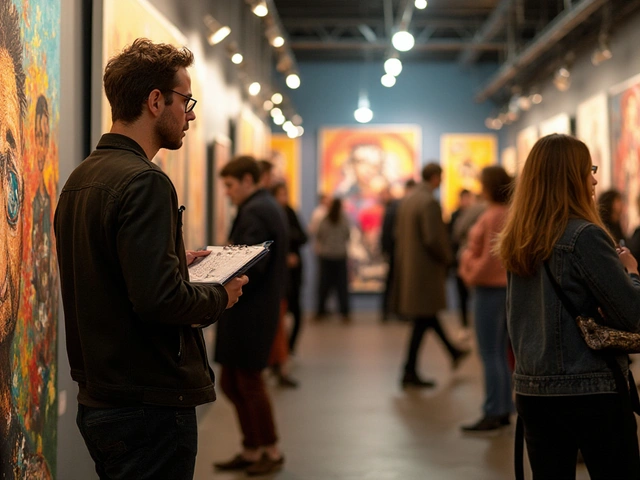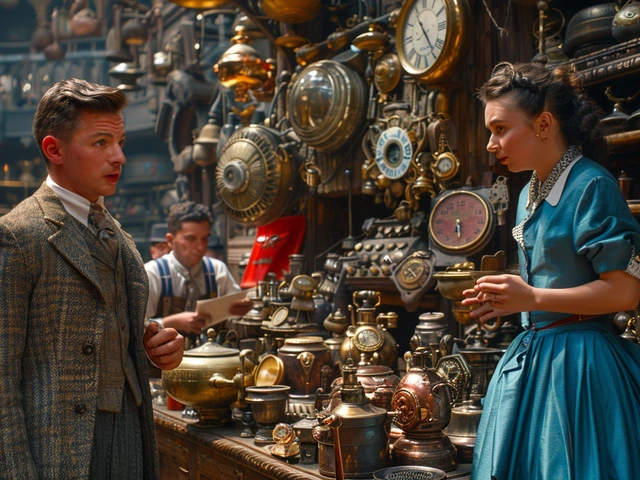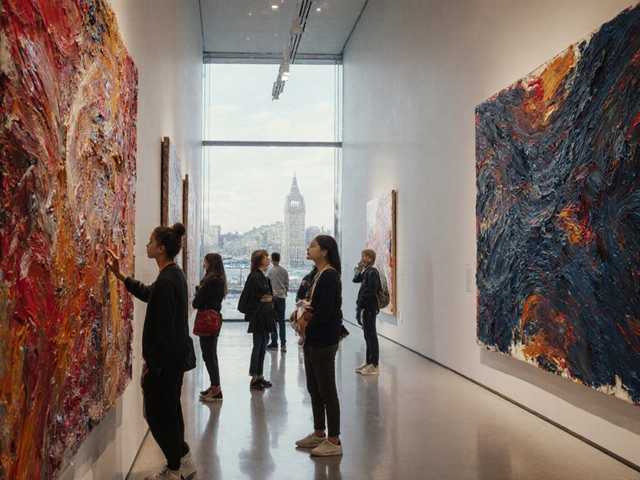Abstract Expressionism stands as a turning point in the history of modern art, marking a shift from the norm and the embrace of freedom and emotion. Born out of the vibrant post-war era, this movement defied traditional art by giving voice to a deep-seated, often chaotic energy that artists like Jackson Pollock and Mark Rothko explored passionately.
Shaped by turbulent times and passionate creators, Abstract Expressionism opened the door to spontaneous creation and artistic abstraction. It focused less on form and more on the emotional intensity conveyed through color and movement. This unique approach transformed how we view and interpret art, making each piece a personal journey rather than a mere display.
- The Origin and Historical Context
- Key Artists and Their Contributions
- Techniques and Characteristics
- Impact on Modern Art
- Collecting and Appreciating Abstract Expressionism
The Origin and Historical Context
Abstract Expressionism emerged as a distinct movement in the late 1940s and early 1950s, chiefly in New York City, which had started to blossom as an intellectual hub post-World War II. This was a time when artists sought to break free from the conventional styles and themes that had dominated art up to that point. The movement was largely shaped by the social and cultural upheavals of the time, with many of its pioneers having been profoundly influenced by the traumas of the war, which they expressed through their art. The emotional intensity and large-scale canvases became hallmarks of this art form, reflecting a desire to confront the subconscious and elevate abstract art into new realms of freedom. This era saw a profound shift in the anchor points of the art world, with New York City beginning to rival Paris as a center for artistic innovation.
Their influence came in part due to the immigration of European artists fleeing the ravages of WWII. These figures, often associated with movements such as Surrealism and Cubism, brought new ideas that meshed with the expressive potential of American painters, leading to a unique cross-pollination of ideas and techniques. The collective experiences of artists such as Jackson Pollock, Willem de Kooning, and Mark Rothko drove them to develop a language of abstraction that was emotionally potent and visually arresting. It challenged viewers to engage with art on a deeper, more personal level. The movement was also supported by influential critics like Clement Greenberg, who believed Abstract Expressionism represented the highest form of American art. He championed the movement as the peak of artistic purity — the fusion of color and form to evoke sublimity.
The roots of Abstract Expressionism can be traced back to the momentum of previous art movements like Post-Impressionism and Fauvism, which emphasized emotion and personal expression. Yet, in its abstraction, it diverged sharply from the precision and clarity that had marked earlier modernist movements. The gestural brushstrokes and almost anarchistic embrace of color symbolized a new way to view the world, often reflecting the political currents and a sense of existential dread underlying much of mid-20th-century thought. In this context, the canvases became arenas where an artist's psyche could wrestle with notions of existence and identity, making room for the art world to explore the invisible beneath the visual.
The painter Rothko once explained, "A painting is not about an experience. It is an experience." His words encapsulate the core ethos of Abstract Expressionism, where the interaction between the viewer and the art itself becomes a personal journey, distinct for every individual.
Collectives such as the New York School became pivotal in fostering an environment of collaboration and encouragement among artists. These groups often held heated debates about the trajectory of art, echoing the fervent dialogues of earlier avant-garde collectives in Europe. Due to the lack of rigid formalism that characterized their work, many Abstract Expressionists embraced a variety of methods, sometimes even within a single piece, highlighting the diversity within the movement itself. They utilized techniques such as action painting and color field painting, exploring the use of unpremeditated spontaneity and carefully modulated flatness, respectively. These techniques opened new artistic pathways, which would heavily influence subsequent movements like Minimalism and Pop Art as artists continued to push the boundaries of traditional art into the unknown.
Key Artists and Their Contributions
When diving into the realm of Abstract Expressionism, one's journey inevitably intertwines with the vivid stories and groundbreaking works of its most celebrated artists. A pivotal figure in this art movement was Jackson Pollock, often recognized for his unique drip painting technique. Pollock's unconventional method of pouring paint led to a dynamic form of expression, where control and chaos danced intricately across the canvas. His work, such as "No. 5, 1948," demonstrates how randomness and intent can coexist, breaking the mold of traditional art teachings that prioritized form and linearity. By laying his canvases on the ground, Pollock let gravity dictate certain aspects of his creations, inviting spectators to interpret unpredictable patterns and swirling colors that seemed to breathe life.
Mark Rothko, a contemporary of Pollock, offered a contrasting yet equally profound contribution to Abstract Expressionism. Rothko's focus was on color and form, which he used to evoke emotional depth and contemplation. His compositions consisted of rectangles with blurred edges, softly layering hues upon hues. Works like "Orange, Red, Yellow" are not mere visual experiences but portals to introspective and emotional worlds. Rothko’s philosophy aimed to transcend mere abstraction, creating spiritual encounters for viewers with his use of vast expanses of color. It is remarkable how his seemingly simple paintings demand such complex emotional reactions, a testament to his genius in exploring human emotion through art.
Besides these two titans, Willem de Kooning emerged as a cornerstone of this avant-garde movement. Known for his energetic and often aggressive brushwork, de Kooning’s pieces blended abstraction with figuration, challenging the viewer's perception. In his "Woman Series," de Kooning distorted the female form, imbuing it with violent and sensuous elements that questioned societal views on femininity. His work often sparked discussions about the relationship between man and society, guiding contentions on perceptions and emotions conveyed through visual art. Interestingly, de Kooning's art was not confined to one style or method, reflecting Abstract Expressionism's core principle: fluidity over rigidity in creativity.
Here and there in the evolution of Abstract Expressionism, we see the overwhelming influence of these pioneering figures, each contributing a unique vision yet bonded by the same desire to explore artistic freedom. Their works have not only shaped the movement but have also offered new perspectives on interpreting human emotions through art. Together, Pollock, Rothko, and de Kooning, among others, forged a path that has inspired countless artists and left an indelible mark on the world of modern art.
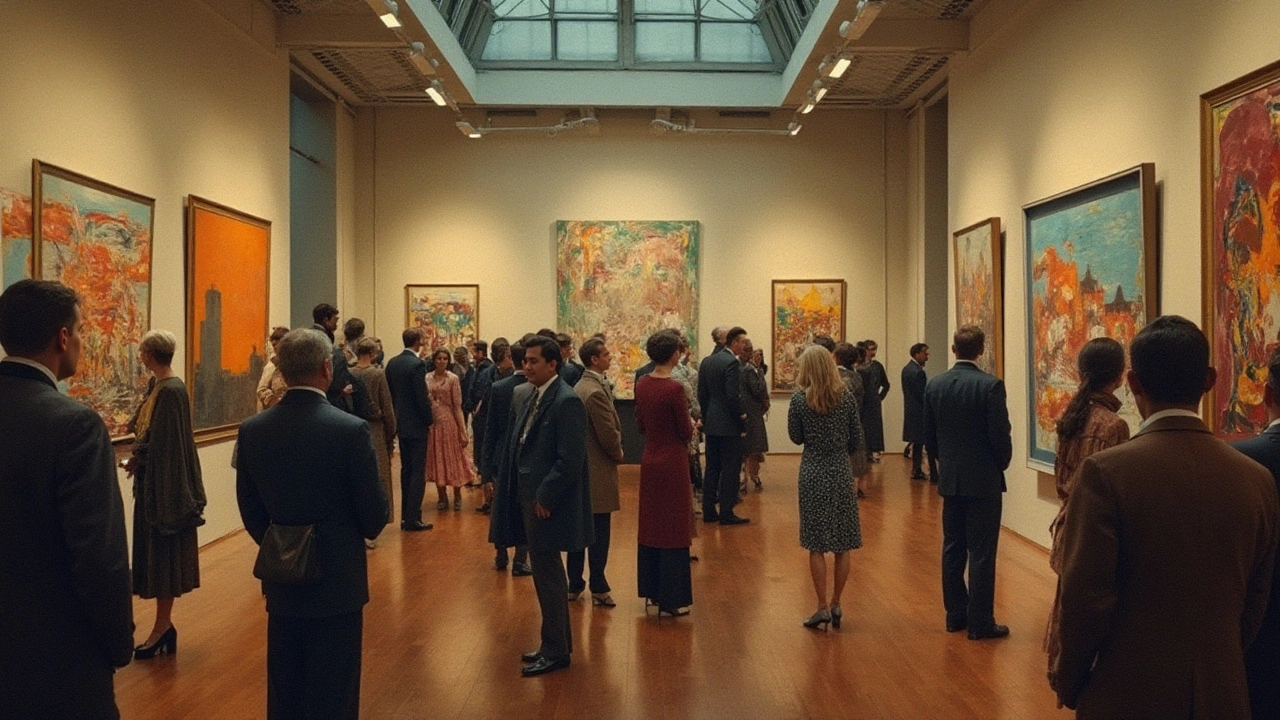
Techniques and Characteristics
At the heart of Abstract Expressionism lies a dynamic interplay of techniques and characteristics that set the stage for a radical departure from previous art movements. One of the most distinctive techniques is action painting, a style popularized by Jackson Pollock. In action painting, the canvas becomes an arena where the artist can manipulate paint with vigorous strokes, drips, and splashes, creating an unrestrained and powerful expression. This method transformed the way art was perceived, allowing a glimpse into the artist's subconscious thought process through highly gestural gestures. Pollock famously said, "I want to express my feelings rather than illustrate them," highlighting the emotional intensity that drove this technique. This energetic approach invites the viewer to step into the artist's mindset, resonating with the vigor and unpredictability that characterized post-war America.
Another significant characteristic of this movement is color field painting, epitomized by the works of Mark Rothko and Barnett Newman. In this technique, artists prioritized large fields of flat, solid color spread across the canvas, aiming to evoke an emotional response through simple, yet profound visual language. The focus shifts from narrative details to the essence of mood and spirituality, compelling viewers to engage with a more meditative form of art. Rothko believed that color field painting could transcend the bounds of traditional subject matter, reaching deeper emotional and philosophical experiences. The canvas becomes a doorway to another dimension, where form is secondary to feeling.
The spontaneity of Abstract Expressionism also includes improvisation in form and content. Artists in this movement were less concerned with precise outlines or recognizable shapes and more with conveying raw emotion and universal themes. In doing so, they opened new possibilities for creative expression, offering a stark contrast to the formalism and orderliness of previous artistic styles. This emphasis on individual self-expression was a reaction against the rigidity of socially and politically charged art, making space for personal reflection and introspection. The audience becomes a participant in the artwork, their interpretations as important as the initial creation.
Material choices, too, were important in this movement. Artists frequently used non-traditional materials and tools, such as house paints and custom brushes, to achieve desired textural effects and lack of restraint. This resourcefulness was partly due to the scarcity of art materials during the post-war period but also reflected a broader rejection of traditional norms. Through this rebellious spirit, Abstract Expressionism underscored a freedom that was as much about choice of medium as it was about technique. Some artists even left portions of the canvas untouched, allowing negative space to play a role in the viewer's experience, which further pushed the envelope of what constituted a finished work of art.
Table of common Abstract Expressionism techniques and their impact:
| Technique | Artist | Impact |
|---|---|---|
| Action Painting | Jackson Pollock | Introduced kinetic energy and process as part of the artwork. |
| Color Field | Mark Rothko | Elicited profound emotional responses through simple forms. |
In exploring the techniques and characteristics of Abstract Expressionism, one discovers a rich tapestry of innovation and emotional depth that left an indelible mark on modern art. This movement paved the way for future generations of artists, allowing them the freedom to explore the inner complexities of human nature and encouraging a continual evolution in the expression of art.
Impact on Modern Art
Abstract Expressionism left a remarkable imprint on the landscape of modern art, ushering in a new era that profoundly challenged and expanded creative boundaries. This movement, largely concentrated in mid-20th century America, shifted the focal point of the art world from Europe to New York City. The relentless pursuit of personal expression over conventional aesthetics, embodied by artists like Jackson Pollock and Willem de Kooning, redefined the global art narrative. Modern art, as a result, began to place a higher value on individual experience and emotional intensity, which resonated deeply with audiences seeking authenticity in a post-war world fraught with change.
One of the landmark contributions of this movement was the concept of art as a process rather than a product. The energetic splashes and drips of Pollock's canvases symbolized a direct engagement with the act of creation, thus shifting the focus towards the 'act' of painting itself. This liberated approach inspired new generations of artists to view the canvas not as a mere surface to cover, but as a ground for action, exploration, and experimentation. It also encouraged artists to embrace more spontaneous methods, often avoiding the limitations imposed by traditional techniques or tools. Such methodologies paved the way for later artistic movements, such as Action Painting and minimalism, which drew from the raw, unfiltered emotion of Abstract Expressionism.
The Cultural Shift
The cultural shift that ensued from Abstract Expressionism’s rise was not just limited to the visual arts. It mirrored broader societal changes, echoing the freedom-seeking attitude prevalent during the time. This art form embraced the existential notion that the meaning of life was more complex, chaotic, and less structured than previously believed. Therefore, artworks became reflections of the unpredictable nature of human existence and emotions, resonating with audiences on a profound level. It emboldened artists across disciplines, influencing literature, music, and even theater, fostering a more holistic interpretation of modern art that emphasized emotional resonance and personal experience over technical perfection or rigid structure.
"Abstract Expressionism was reasonable because it actually transpired from its own irrationalism; it allowed for chaos to enter the heart of art," famously remarked art critic Harold Rosenberg, highlighting the radical departure from the past.
Furthermore, institutions and galleries greatly proliferated during this period, further institutionalizing Abstract Expressionism as not just a fleeting trend, but a fundamental component of art education and appreciation. This ensured its continued influence and relevance in subsequent decades, where it still inspires interpretations and reinterpretations by contemporary artists seeking a genuine connection with their audience through their work. The legacy of Abstract Expressionism in modern art is thus one of liberation and unbound creativity, reminding us that at the heart of artistic expression is the freedom to break from tradition and forge one's own path.

Collecting and Appreciating Abstract Expressionism
Delving into the world of collecting Abstract Expressionism is an exhilarating journey. This art movement, prominent in the mid-20th century, offers collectors a unique blend of historical significance and emotional depth. The value of pieces can often fluctuate, influenced by the artist's prominence, the work's condition, and its provenance. Serious collectors often focus on significant works by pioneering figures such as Jackson Pollock, whose daring, all-over drip paintings disrupted conventional methods, or Mark Rothko, whose canvases vibrate with serene blocks of color. Each piece invites the viewer on a subjective journey, sweeping them into the artist's realm of raw emotion.
The process for acquiring these works typically begins with understanding the fundamental traits that define Abstract Expressionism: spontaneity, gestural brush-strokes, and the emphasis on conveying emotions rather than representing objects. Collectors must immerse themselves in the history and techniques, often attending gallery exhibitions and art fairs where like-minded enthusiasts and experts gather. Auction houses serve as pivotal venues, where battle-ready bidders vie for the movement’s masterpieces. Often, collectors seek guidance from art historians or critics, or join clubs dedicated to Abstract Expressionism, where insights are shared, and the oeuvre is revered. According to curator David Anfam, "Understanding these pieces is like deciphering a deeply personal message sent through universal signals."
Acquisition isn't merely about financial investment but the passionate engagement with a piece of history and emotion that Abstract Expressionism embodies. Some collectors are driven by the aesthetic allure, while others are captivated by the storied lives of artists who lived and breathed the bold defiance of this movement. To safeguard these investments, proper maintenance is crucial. This includes climate-controlled storage, regular cleanings, and insurance to cover any potential damage. Those who invest in these pieces often find themselves deeply connected to their collection, engaging with it in profound and unexpected ways.
For art enthusiasts who are beginning their collection or simply wish to appreciate Abstract Expressionism, museums offer invaluable resources. Iconic institutions such as MoMA in New York City or the Guggenheim house monumental pieces that can be studied and admired. Art books and documentaries also provide insightful retrospectives and critical analyses, expanding one's appreciation far beyond mere visual engagement. Often, these resources illustrate how the movement reshaped perceptions of what art could represent on the global stage.
In the world of art, the value of Abstract Expressionism not only hinges on rarity and historical worth but perpetually revolves around the viewer's personal interaction with each piece. As collectors display these works in their homes or private galleries, the dialogue between the artwork and the observer continues to grow, reminding us of art’s enduring power to move and transform. Thus, the personal journey of collecting this art form mirrors the dynamic and expressive nature that defines it. Whether one views it as an investment or an enduring passion, the appreciation of Abstract Expressionism ensures its legacy endures.

